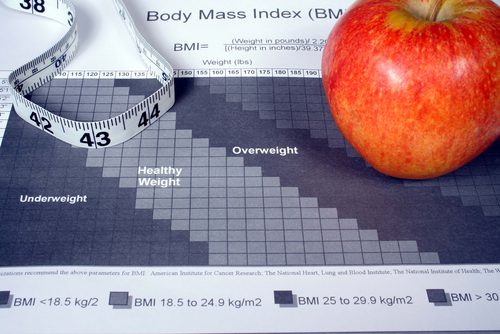Obesity, Nutrition, & the Spine
Obesity can cause injury and damage to the spine. This damage can lead to chronic pain and other symptoms associated with osteoarthritis, rheumatoid arthritis, osteoporosis, degenerative disc disease, spinal stenosis, and many other spinal conditions. The American Academy of Neurosurgeons reports that 66% of arthritis patients are either overweight or obese and obese patients are 4-5 times more likely to be diagnosed with osteoarthritis.5
Maintaining a nutrient-rich diet that provides all of the nutrients important in bone health is one way to lessen the burden on the spine and increase overall bone health.
The Spine
The spinal column runs from the base of the skull to the pelvis and functions mainly to support the body’s weight, allow for its movement, and protects the spinal cord. The unique S-curvature design of the column enables the spine to carry and evenly distribute the body’s weight.
The spine is divided into three distinct regions (cervical, thoracic, and lumbar) of stacked vertebrae. These vertebrae are the building blocks of the spinal column and bear the majority of the weight put upon the spine. Between each vertebrae is a round flat disc that provides cushion and absorbs the pressure produced when walking, running, or jumping. Each disc has a strong outer ring of fibers called the annulus and a soft, jelly-like center called the nucleus pulpous. The vertebrae are held together by groups of connective tissue, ligaments, and tendons.
The spine is also designed to protect the spinal cord. The spinal cord is a column of nerves that connects the brain with the rest of the body, controlling movement and organ function.
Bone
The bones of the body are dynamic, living tissues with a collagen-protein construction that allows them to be both flexible and strong. Throughout life, bones are in a constant state of teardown and repair. Osteoclast cells remove old bone via resorption and osteoblast cells form new bone. This ongoing process is regulated largely by nutritional status, hormone levels, and the dietary intake of specific nutrients.
Mature bone is composed of the nutrients found in protein, fats, vitamins, minerals and water. Approximately 60% of the weight of bone comes from the minerals calcium and phosphate. Much of the remaining weight comes from water and the bone matrix, which is formed before the minerals are deposited, and is often referred to as “scaffolding” for the bone. About 90% of the bone matrix proteins are collagen, which is the most abundant protein in the body. Collagen is a very strong fibrous protein which provides bone with strength and flexibility and is an important component of many other tissues, including skin, cartilage, and tendon.
Diet
There are as many as 20 essential nutrients necessary for optimal spine and bone health; all of which work together to keep bones healthy and strong over the course of a lifetime. Nutrition status will determine bone and connective tissue strength and can predict how efficiently the body will repair its infrastructure of cartilage, ligaments, tendons, and muscle. Many diseases and spinal conditions can be linked to diet. Osteoporosis is an example of a spine-related condition with a clear link to nutritional status.
Osteoporosis is characterized by low bone mineral density and a structural deterioration of bone tissue which increases fracture risk. Although osteoporosis can occur at any age, it is most common in those over age 50.5 Many nutrients play a role in maintaining optimum bone mineral density and overall spine and bone health. Among these nutrients are the minerals calcium, phosphorus, magnesium, and potassium; vitamins D, K, B6, B12, and folic acid; essential fatty acids omega 3 and omega 6; and antioxidants.
The importance of dietary calcium on bone health is well established. Calcium intake and its proper metabolism are essential for healthy bone development and maintenance and give bones both strength and rigidity. Intake levels between 1,000 -1,500 mg/day are optimal, with levels below 1,000 mg/day associated with lower peak bone mass in studies.6
Phosphorus works in balance with calcium in the bones and blood. 85% of the body’s phosphorus is found in bone, where it binds with calcium to form the mineral hydroxyapatite, which gives strength and rigidity to bones. Low intakes of dietary phosphorus can be accompanied by bone demineralization and the loss of calcium in the urine.
Magnesium is essential for absorption and metabolism of calcium. It also helps stimulate the production of calcitonin and parathyroid hormone, which regulate the use of calcium and phosphorus in the body. Magnesium deficiency may play a role in osteoporosis. Research has shown higher intakes of dietary magnesium correlate with higher hip bone densities in men and women.7-8
Studies have shown positive associations between dietary potassium intake (in the form of fruits and vegetables) and bone mineral density in pre-menopausal, peri-menopausal, and post-menopausal women and elderly men.7-8 Potassium-rich foods help buffer acids in the body and maintain acid–base balance by reducing the net acid content of the diet. The effect of a reduction in dietary acid is the preservation of calcium in bones and decreased urinary acid and calcium excretion, which results in increased bone formation and decreased bone resorption. 23
Vitamin D is a fat-soluble vitamin that is essential for maintaining normal calcium metabolism by increasing its absorption in the intestines and kidney. It aids in preventing bone loss by helping to rebuild new bone and strengthen collagen. Vitamin K is required for the synthesis of osteocalcin, a bone matrix protein that provides structure to bone tissue. It also aids in the binding of calcium to the bone matrix and has been associated with decreased bone turnover and urinary calcium excretion. The B vitamins folate, B12, and B6, are important cofactors in homocysteine metabolism. Observational studies have suggested that poor dietary intakes and low blood concentrations of these B vitamins may be associated with decreased BMD, greater bone loss, and higher risk of osteoporotic fracture.7-8 Elevated levels of B vitamins may also stimulate bone formation.
Essential fatty acids (EFAs) are found in the cell membranes of cartilage and bone and play various roles in bone structure, function, and development. EFAs help increase calcium absorption in the GI tract, help reduce and regulate urinary calcium excretion, and reduce production of the pro-inflammatory eicosanoids in the body. EFAs have also shown to increase calcium deposition in bone and improve bone strength, possibly by stimulating collagen synthesis .6,9-11
Inflammatory conditions involving bone such as osteoarthritis and rheumatoid arthritis can also benefit from omega 3 fatty acids EPA, DHA, and ALA.9-13 A 2007 meta-analysis of over 13 studies suggested the eicosapentaenoic acid (EPA) and docosahexaenoic acid (DHA) omega-3 fatty acids found in fish oil have anti-inflammatory properties that can provide effective relief from joint pain. Taking omega-3 fatty acids for three to four months helped reduce joint pain intensity, minutes of morning stiffness, the number of painful or tender joints, and use of non-steroidal anti-inflammatory drugs (NSAIDs). 12 A small US trial confirmed similar findings with walnuts and flaxseed oil, stating a diet rich in these plant omega-3 alpha-linolenic acids (ALA) improved bone health. 13
Increased antioxidant intakes of carotenoids, particularly lycopene, have also been shown to provide some level of protection against losses in bone mineral density. This protection was seen at the lumbar spine in women and at the hip in men, according to data from a 2009 study in the American Journal of Clinical Nutrition.12-13
Dieting can have a largely negative impact on bone health. In fact, lifelong dieting and restrained eating has been shown to put obese women at risk for low bone mass, specifically at the lumbar spine and femur. 5 A much more effective way to achieve optimal bone and spine health is to increase daily intakes of bone-healthy nutrients by concentrating on nutrient-rich, whole foods. Nutrient rich foods are those that provide a substantial amount of nutrients and relatively few calories. Energy rich foods provide a substantial amount of calories and relatively few nutrients. A nutrient rich diet contains large amounts of bone-building nutrients per calorie consumed. Paying less attention to overall caloric intake and more attention to nutrient density at each meal will greatly increase the vitamin and mineral content of the diet, oftentimes while consuming less total calories.
An eating and lifestyle focused on choosing nutrient-rich whole foods and daily physical activity can be an effective long-term strategy to strengthen bones and connective tissue, alleviate joint pain, and maintain a healthy body weight.
Recommendations to increase nutrient density in the diet and to maintain an ideal body weight include:
- Choose nutrient rich and calorie poor foods most of the time. This includes fruits, vegetables, whole grains, and beans; lean protein sources such as chicken, turkey, fish, >90% lean ground beef, tenderloin, and round cuts of beef; reduced fat cheese, skim milk, and eggs; nuts and seeds
- Include a lean protein, healthy fat, and high fiber, whole grain carbohydrate with each meal and snack. This balance of nutrients helps curb cravings and increases satiety in between meals
- Eat 1.5 oz of dry roasted nuts each day; almonds and walnuts offer the best protection
- Limit intake of processed and refined foods and concentrated sweets
Other strategies to maintain a healthy weight include:
- Practice plate portioning as a means to control caloric intake. Plate portioning utilizes ½ of a dinner plate for salad greens or fresh vegetables, ¼ of the plate for a lean protein and ¼ of the plate for a whole grain carbohydrate
- Eat smaller meals more frequently throughout the day. This prevents dips in blood sugar that cause cravings and/or lead to overeating
Dietary & Supplement Recommendations
Although nutrient-rich foods may hold the key to achieving and maintaining optimal bone health, most Americans do not get adequate intakes of these necessary nutrients in their diet. Supplemental vitamins, minerals, and fatty acids are the best way to ensure the needs of the body are met when the diet does not provide them. Supplementation may be especially necessary for individuals with specific dietary restrictions, food allergies, or decreased absorption of nutrients. At increased risk are the elderly, individuals who spend less than 20 minutes per day in direct sunlight, and those with a spine or bone disease that is linked to nutritional status (e.g., osteoporosis).7,8,13
Dietary factors which may increase the risk for nutritional deficiencies and potentiate a need for supplementation include:
- Limited intake of eicosapentaenoic acid (EPA), docosahexaenoic acid (DHA), omega-3 fatty acids, and omega-3 alpha-linolenic acids (ALA)
- Limited intake of fruits, vegetables, and whole grains
- Limited intake of dietary sources that include calcium, magnesium, and vitamin D (or limited sun exposure)
- Limited intake of dietary protein
Conclusion
The maintenance of a healthy body weight is important to maintain optimal spine health. A well balanced diet is an effective tool in achieving this goal. Once spine degeneration has started it is often too late to reverse the situation. By observing a proper lifestyle and diet, it is possible to reduce the chances of developing spine disease.



